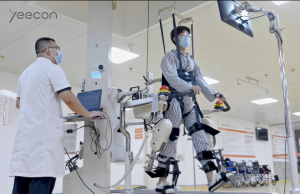1. EMG Biofeedback Combined with Comprehensive Rehabilitation Training
Adding EMG biofeedback therapy on the basis of exercise therapy can better improve the muscle strength of the lower extremity tibialis anterior muscle on the affected side, inhibit the stretch reflex of the triceps calf, reduce its muscle tension, correct abnormal movement patterns, and promote the he generation of isolated movement of the affected side lower extremity, thereby promoting the recovery of the motor function of the affected lower extremity.
The functional rehabilitation training of limbs can promote the improvement of brain function in a certain degree. At the same time, functional rehabilitation training can accelerate the establishment of collateral circulation in brain tissue, promote the reorganization and compensation of brain cells around the lesion, and help to stimulate the “plasticity” of brain tissue.
The standing, gait and stair climbing exercise in rehabilitation training can promote the recovery of walking ability, establish correct gait posture, exercise coordination function and improve the quality of life activities of patients. This integrated therapy can improve the limb motor function of stroke patients, reduce the degree of disorder in abilities of daily living, and promote the recovery of limb muscle strength.
2. Electrical Stimulation Therapy
In 1960s, liberson successfully corrected the foot drop gait of hemiplegic patients by the use of electrical stimulation of peroneal nerve for the first time. Studies have shown that FES can effectively restore or reconstruct part of the motor function of paraplegia patients by stimulating the motor muscles and peripheral nerves of the limbs through the current pulse sequence.
3. Gait Rehabilitation Training Method
According to the different degree of lower limb rehabilitation, in clinal application, the walking training process follows the procedure of: weight support – conventional – weight bearing.
Weight support training can well realize the rehabilitation of patients with severe lower limb disorders; Routine training is generally aimed at patients with lower limb disorders of a lesser degree; The weight-bearing training is aimed at the patients with lower limb disorders of a lesser degree or patients who are about to recover. The deweighting passive gait training is an effective method for the early interventional therapy.
4. Weight Bearing Gait Rehabilitation Training
Some clinical studies have shown that conventional balance training and moderate weight-bearing training of affected lower limbs can improve the balance and walking function of stroke patients.
5. Conventional Gait Rehabilitation Training
The conventional gait training is usually used as a control group when exploring a new training method. The routine gait training method can improve the muscle strength of the limbs, promote the relearning of the movement mode and the multi-directional response ability, and increase the weight-bearing capacity of the lower limbs. It can be used as a control group in the early stage of lower limb rehabilitation, and it can also be used for routine gait training after the deweighting gait training at the early stage.
6. Deweighting Gait Rehabilitation Training
Deweighting passive rehabilitation training is one of the most effective methods for the early interventional therapy. At present, the robot used in lower limb rehabilitation training is an intelligent training system developed on the basis of deweighting gait training. The system can not only simulate the walking posture of normal people, but also bear part of the body weight, which can be used to carry out effective rehabilitation training for patients with lower limb motor dysfunction.

Yeecon Gait Robot A3 is one of the lower limb rehabilitation robots for deweighting gait rehabilitation training. It is designed for the early stage rehabilitation training of patients with lower limb dysfunction. It consists of two systems: deweighting system and exoskeleton orthosis. The orthosis adopts exoskeleton bionic structure with hip and knee as the core of movement. Patients can reproduce standard walking patterns under different weight-supported conditions.
Read more:
Advantages of Rehabilitation Robotics
Effective Robotic Rehabilitation Equipment for Lower Limb Dysfunction
How does Rehabilitation Robot A3 Help Stroke Patients?
Post time: Mar-31-2022






